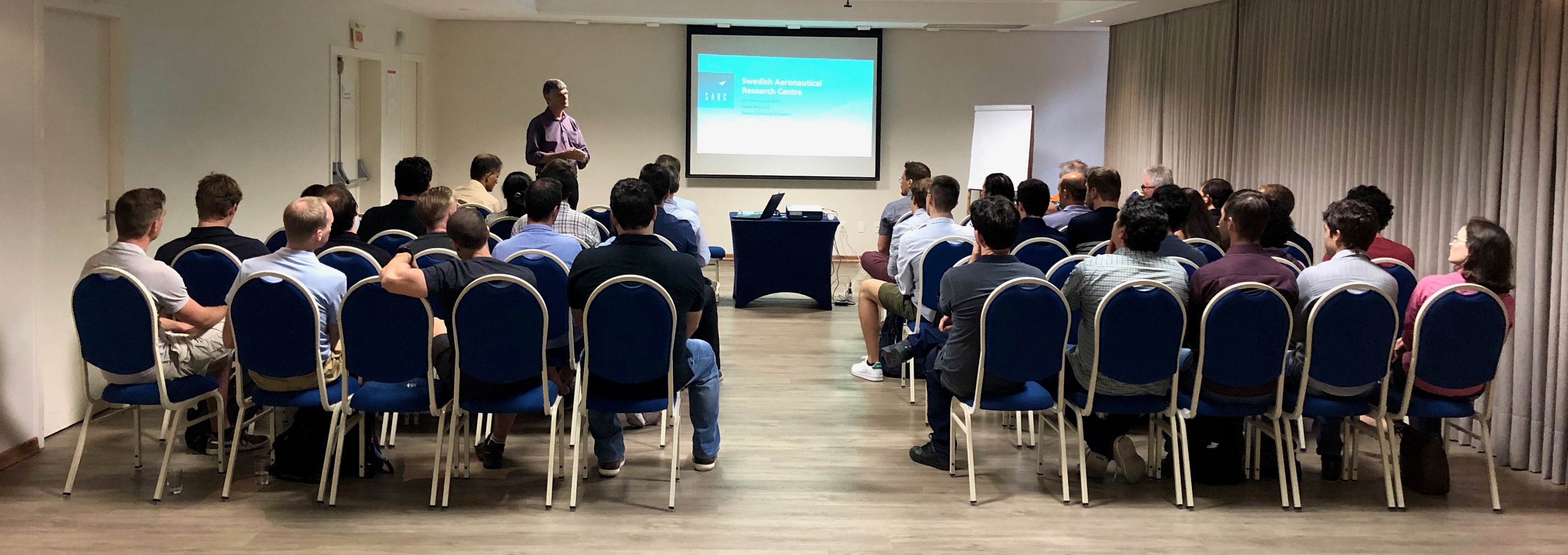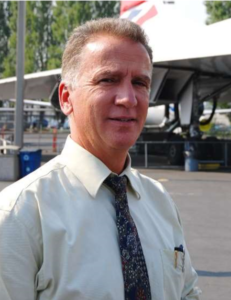
- This event has passed.
SARC.Academy Short Summer School on Conceptual Aircraft Design, March 17-23, 2019, Florianópolis, Brazil
17 March, 2019 - 23 March, 2019

Welcome to the first SARC.Academy short summer school (S4) in collaboration with SC2C.Aero at Florianópolis, Santa Caterina, Brazil.Welcome to the first SARC.Academy short summer school (S4) in collaboration with SC2C.Aero at Florianópolis, Santa Caterina, Brazil.
Course Program
| Day | Time | Program |
| Sunday, 17th | 17:00 – 18:00 | SARC presentation (Dan Henningson) SARC.Academy information (Ingo Staack) SARC-SC2C.Aero Collaboration & Opportunities (Petter Krus & Victor De Negri) |
| 19:00 – 21:00 | Reception | |
| Monday – Friday | Course lectures (see own lecture plan below) | |
| Thursday, 22th | 19:00 – 22:00 | Dinner |
| Friday, 22th | 15:00 – 18:00 | Visit of the Federal University of Santa Catarina and CERTI Foundation including the laboratories at UFSC and CERTI |
| Saturday, 23t (Swedish participants only) | 10:00-11:30 | Future Collaboration and Research Planning: open discussion Session lead by Prof. Petter Krus and the SARC.research team. Take this opportunity to find like-minded researcher/manoeuvre students to broaden your research and expertise horizon! |
| 11:30 – 12:30 | Presentation and WP planning of the SARC collaborative PhD project (Tomas Grönstedt) | |
| 14:00 – 18:30 | Social Event by endorsement:
Excursion by bus through local beaches OR |
|
Course Outline
| Lecture | Topic |
| 1 | INTRODUCTION: Overview of the design process, requirements definition, end products of design. |
| 2 | QUICK DESIGN & SIZING TECHNIQUES: Methods to quickly determine aircraft weight and size required to meet mission requirements, rapid aero/weights/propulsion methods, design trade studies. |
| 3 | WING/TAIL GEOMETRY SELECTION: Selection of wing geometry and tail arrangement. |
| 4 | THRUST-TO-WEIGHT AND WING LOADING, INITIAL SIZING: manoeuvre selection of wing loading and thrust-to-weight (or horsepower-to-weight) ratio to satisfy requirements such as stall speed, climb rate, and manoeuvrability. Refined estimation of takeoff weight and determination of fuselage, wing, and tail sizes. |
| 5 | CONFIGURATION LAYOUT AND LOFT: Design layout of a credible aircraft configuration arrangement including external geometry, conic lofting, flat-wrap development, smoothness verification, cross-section definition, and internal layout. Design layout of wings and tails including airfoil interpolation, trapezoidal and non-trapezoidal geometries, wing location guidelines. |
| 6 | AERO & STRUCTURES CONSIDERATIONS: Design guidance and rules-of-thumb for creation of configuration layouts with good aerodynamics and structural arrangement. |
| 7 | SPECIAL CONSIDERATIONS:
Design impacts of observability (radar, IR, visual, and aural), vulnerability, producibility, and maintainability. |
| 8 | SYSTEMS INTEGRATION: Design integration of landing gear, hydraulics, electrics, pneumatics, and avionics. |
| 9 | PAYLOAD, PASSENGERS, & CREW: Design layout of the crew station, passenger compartment, cargo bays, and weapons integration. |
| 10 | PROPULSION INTEGRATION: Jet engine integration including engine selection, engine scaling, engine location considerations, inlet geometry and location, and nozzle geometry. Propeller engine integration including engine selection and location, cowling, and propeller sizing. Aircraft fuel system considerations. |
| 11 | AERODYNAMIC ANALYSIS: Methods for estimating the aerodynamic lift and drag from low subsonic through supersonic speeds, including the component drag build-up method, the leading edge suction method, and the Sears-Haack wave drag method. Introduction to Computational Fluid Dynamics (CFD). |
| 12 | STABILITY AND CONTROL ANALYSIS: Methods for determining if the design satisfies essential stability and control requirements including trim, nosewheel liftoff, static stability, departure susceptibility, and spin recovery. |
| 13 | PROPULSION ANALYSIS: Methods for calculation of the installed net propulsive force for jet or propeller-driven aircraft, including installation corrections, inlet drag, nozzle drag, and propeller thrust. |
| 14
|
LOADS, STRUCTURES AND WEIGHTS: Aircraft loads, aerospace materials and properties. Introduction to the Finite Element Method (FEM). Estimation of aircraft weights and mass moments using statistical models and corrections for advanced materials. |
| 15 | PERFORMANCE ANALYSIS:
Performance analysis methods for level flight, climb, glide, takeoff, landing, and maneuver. Energy manoeuvrability methods for combat analysis and minimum time/fuel to climb. Fighter measures of merit including agility and post-stall maneuver. |
| 16 | TRADE STUDIES AND COST ANALYSIS:
Refined sizing techniques and discussion of industry methods. Sizing matrix and carpet plot optimization techniques, along with Multidisciplinary Optimization (MDO) methods. Use of performance constraint curves to determine the optimal aircraft. Life Cycle Cost analysis using statistical and operational data. Airline economic analysis |
| 17 | COMPUTER-AIDED CONCEPTUAL DESIGN: Use of CAD in the conceptual design environment, tools for facilitating initial design layout and design iteration. Demonstration of conceptual design CAD and integrated analysis and optimization including MDO methods (RDSwin-Pro). |
| 18 | VTOL, HELICOPTER, AND DERIVATIVE AIRCRAFT DESIGN: Overview of jet VSTOL design and analysis including concepts and integration issues. Helicopter aerodynamics, performance, controls, design, and sizing techniques. Design considerations for the development of derivatives of existing aircraft, including performance, weight, and cost estimation. |
| 19 | INNOVATIVE DESIGN CONCEPTS:
Overview of innovative design concepts including Canard, Flying Wing, Joined-Wing, Blended Wing Body, Unmanned Aircraft (UAV), Asymmetric, and others. |
| 20 | DESIGN EXAMPLES: Review of prior lessons by a step-by-step design examples from initial requirements and first sketch to completed configuration layout and optimization |
About the Instructor -Daniel P. Raymer, Ph.D.
The 2010 recipient of the AIAA Aircraft Design Award, Dr Daniel Raymer is a recognized expert in the areas of Aerospace Vehicle Design and Configuration Layout, Computer-aided Design Methodologies and Design Education. An AIAA Fellow and recipient of the AIAA Summerfield Book award, he was named Rockwell Engineer of the Year for his pioneering work in aircraft computer-aided conceptual design. Dr. Raymer is the author of the best-selling textbook “Aircraft Design: A Conceptual Approach” and the mass-market books “Dan Raymer’s Simplified Aircraft Design for Homebuilders” and “Living in the Future: The Education and Adventures of an Advanced Aircraft Designer.” He regularly teaches his popular five-day Aircraft Conceptual Design Short Course, a two-day Advanced Aircraft Design Short Course, a three-day Short Course in Aircraft Design Management, Requirements Definition, and System Engineering, and a course in Unmanned Air Vehicle (UAV) Design.
 Dr. Raymer is President of the design and consulting company, Conceptual Research Corporation, and conducts design studies and consulting for NASA, the USAF Research Lab (WPAFB), DARPA, Composite Engineering Inc., and others. He is a regular Forum Speaker at the EAA AirVenture (Oshkosh). His previous positions include Director-Advanced Design with Lockheed, Director-Future Missions at the Aerojet Propulsion Research Institute, and Project Manager-Engineering at Rockwell North American Aviation. He was Head of Air Vehicle Design for X-31 during the conceptual design phases, and was intimately involved in the actual configuration definition. He also consulted with both RAND and CNA during the JAST/JSF concept development phase.
Dr. Raymer is President of the design and consulting company, Conceptual Research Corporation, and conducts design studies and consulting for NASA, the USAF Research Lab (WPAFB), DARPA, Composite Engineering Inc., and others. He is a regular Forum Speaker at the EAA AirVenture (Oshkosh). His previous positions include Director-Advanced Design with Lockheed, Director-Future Missions at the Aerojet Propulsion Research Institute, and Project Manager-Engineering at Rockwell North American Aviation. He was Head of Air Vehicle Design for X-31 during the conceptual design phases, and was intimately involved in the actual configuration definition. He also consulted with both RAND and CNA during the JAST/JSF concept development phase.
Dr Raymer received B.S. and M.S. engineering degrees in Astronautics and Aeronautics from Purdue, an MBA from the University of Southern California, and a Doctorate of Engineering (PhD) from the Swedish Royal Institute of Technology (KTH) in the field of Aircraft Multidisciplinary Design Optimization. He is a recipient of the Purdue University Outstanding Aerospace Engineer Award given to “honour those alumni who have distinguished themselves in the aerospace industry”.
